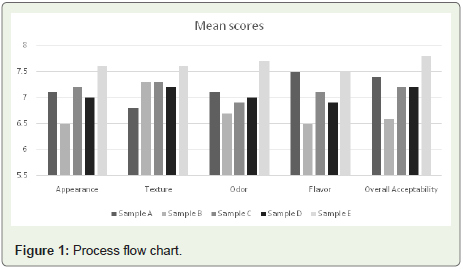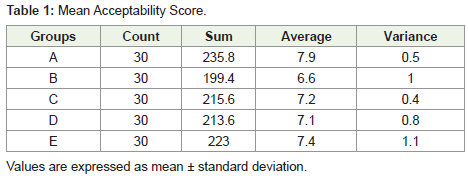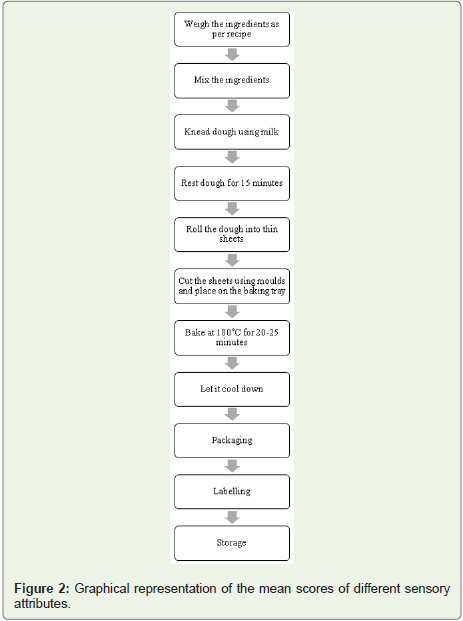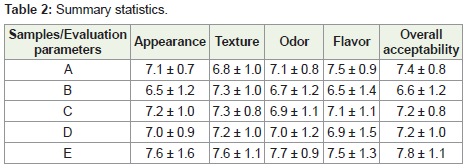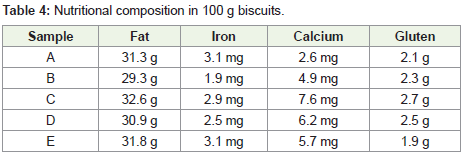Research Article
Formulation of Water Chestnut Flour and Ragi Flour Biscuits for Celiac Patients and Study on Their Nutritional Attributes and Sensory Evaluation
Gupta A* and Awasthi M
Department of Nutrition and Dietetics, Manav Rachna International Institute of Research and Studies, India
*Corresponding author: Gupta A, Department of Nutrition and Dietetics, Manav Rachna International Institute of Research and
Studies, Manav Rachna International University, Faridabad (121004), Haryana, India; E-mail: aashgpt@gmail.com
Article Information: Submission: 10/12/2020; Accepted: 11/01/2021; Published: 15/01/2021
Copyright: © 2021 Gupta A, et al. This is an open access article distributed under the Creative Commons Attribution License, which permits unrestricted use, distribution, and reproduction in any medium, provided the original work is properly cited.
Abstract
Introduction: The study was designed to carry out to formulation of biscuits enriched with calcium, iron and folic acid for the patients diagnosed with celiac disease. Celiac disease is said to be an autoimmune disorder which occurs because of the absence of transglutamase enzyme in the patients. With the consumption of gluten in food sources like wheat, semolina etc., the patient suffers from inflammation. To avoid the indigestion caused amongst the patients suffering with celiac disease one must follow up gluten-free products in the diet.
Objective: The objective of this research was to prepare the nutritional rich biscuits using gluten-free products i.e., water chest flour and ragi flour.
Method: Research papers were studied related to the benefits of ragi and chestnut flour and reviewed the finding of each article. Five forms of biscuits were prepared a) Control A (100% Water chestnut flour), b) Control B (100% Ragi flour), c) Sample 1 (50% WCF & 50% RF), d) Sample 2 (25% WCF & 75% RF) and e) Sample test 3 (75% WCF & 25% RF). The recipe of nutrients rich biscuits was standardized on the basis of sensory evaluation.
Result and Conclusion: It was observed that the biscuits prepared with 75% of water chestnut flour and 25% of ragi flour (Sample E) were most acceptable. The nutritional analysis of the biscuits revealed that the total fat content was 31.8g/100 gms, calcium content in the biscuits was found to be 5.7 mg/100 gms and the iron content was tested as 3.1mg/100gms. Water chestnut and ragi are said to be rich in calcium and iron and are safe for patients
suffering with celiac disease due to their gluten-free property. The calcium deficiency leads to bone and teeth disorder and iron deficiency leads to anaemia. Although these are natural sources of gluten free foods but gluten cross contamination should be avoided during production.
Keywords
Gluten-free biscuits; Celiac disease; Transglutamase; Enzyme; Sensory evaluation; Nutritional analysis
Introduction
Celiac disease is a disorder which causes inflammation in the
small intestine due to ingestion of gluten in genetically susceptible
individuals [1]. This disorder is caused due to the absence of
transglutamase enzyme in the individual’s body. Malabsorption of
nutrients such as iron, folic acid, calcium and fat-soluble vitamins
causes inflammation. Establishment of a gluten free diet is a key
evidence for the clinical and mucosal recovery which states that the
enteropathy is gluten induced. It is said that on average 1 in 200 is likely
to get affected with symptoms mostly appearing in the adulthood. To
prevent inflammation, gluten-free diet should be given to the patients
[2]. It has been observed that even after the consumption of glutenfree
diet patients suffer from various deficiencies such as calcium,
iron, fibre and folic acid [3]. Nowadays, many gluten-free products
are available in the market but the nutritional value of these products
cannot be established. Water chestnut and Ragi are the most easily
accessible gluten-free sources among the others available.
Water chestnut (Eleocharis dulcis), is a plant which belongs to the Trapaceae family and is popularly known as Singhara in India. It is a great source of nutrients and is known to have positive effects on physical health. It is rich in many invincible nutrients such as essential amino acids (4-7%), vitamins E and vitamin B-complex, minerals (potassium, calcium, phosphorus and magnesium), sugar (20-32%), starch (50-60%), dietary fibre (4-10%) and low amount of fats (2-4%) [4-10]. The edible portion of the plant which is
mainly the fruit, is cherished for its gluten-free content [11] and possesses many therapeutic properties such as antimicrobial activity, antidiabetic activity, analgesic activity, anti-inflammatory activity, morpho-physiological activity, astringent, antileprotic agent, urinary discharges, sore throat, anaemia, osteoporosis and bronchitis [12].
Ragi (Eleusine coracana) is the largest cultivated crop among
other cereals in India. The finger millet is well known for its nutritional
composition and has a good impact on health [13]. The nutritional
values in the 100g of the crop is seen as - Moisture (12%), protein
(7.7 g), fat (1.5 g), ash (2.6 g), crude fibre (3.6 g), carbohydrates (72.6
g), calcium (350 mg), iron (3.9 mg), thiamine (0.42 mg), riboflavin
(0.19 mg), niacin (1.1 mg), and energy (1406KJ). Additionally, there
is presence of 5.6% weighed husk. There is good amount of protein,
fat and minerals (like calcium, iron and phosphorus) in finger millet
as compared to rice, corn and sorghum [14]. Ragi can therefore be
used in the development of any gluten-free product due to absence of
gluten from the crop [15].
The Indian bakery industry has picked up a growth momentum
since 2004 and has grown at a rate of 9.0% from 2010 onwards,
mainly impacted by the increased demand for convenience products
and health food products. Within all bakery products, biscuits and
cookies are widely consumed by the rural as well as urban population.
This is generally because of a longer shelf life, easy to bake recipe,
effective marketing and low-cost production. They are also available
in varied tastes and textures customized as per consumer demand
[16].
The bakery products like biscuits are mostly based on wheat flour
or refined flour and the replacement with water chestnut and ragi
flours will be beneficial for the celiac patients due to their gluten-free
properties along with increased nutritional quality and their health
benefits on nutrient deficient individuals. Therefore, an attempt
has been made to develop water chestnut and ragi based nutritious
biscuits. Nutritional and sensory evaluation of these biscuits has also
been carried out.
Materials and Methods
A research study was conducted in the laboratory of the
Department of Nutrition and Dietetics, Manav Rachna International
Institute of Research and Studies, Manav Rachna International
University, Faridabad, India. The study included primary as well as
secondary research.
Many scholarly articles and research papers proved beneficial
in gaining theoretical understanding of the subject. This helped in
finalizing the ingredients for the product to be developed and the
parameters used to measure its success. The gluten-free product was
then developed in the laboratory after many rounds of experiments.
To test the product on the selected parameters of the study, a primary
research was conducted where the final products were tasted by
a neutral sample population and the results were recorded for
further analysis. Statistical analysis was then performed to check the
performance of these products on the parameters selected. The results
have been presented towards the end of this paper.
Procurement of raw materials:
The raw materials required for the development of the gluten
free products were purchased from the local market. This included
Water chestnut and Ragi flour, powdered sugar, oil, baking powder
and milk.Formulation:
In order to make the biscuits, all the raw materials weighed as
per recipe (chestnut flour, ragi flour, powered sugar, baking powder
and oil) were taken together in a bowl and mixed well. Then milk
was gradually added to prepare dough by kneading together all the
ingredients. The dough needs a resting period of 15 minutes at room
temperature. Then flat sheets were formed using the dough prepared,
which was molded and dropped on the baking trays. These trays
were then placed in oven for baking. After baking at 180 ˚C for 20-25
minutes, the trays were taken out from the oven, and the biscuits were
given a cooling period of 30 minutes at room temperature to become
finally ready for consumption (Figure 1).Physical properties:
Many variants of biscuits were made using different combinations
of Water chestnut flour and Ragi flour. 100 grams biscuits were
considered for determining the physical properties of each variation.
The two control samples of the biscuits were Control Sample A which
was prepared by 100% Water chestnut flour whereas Control Sample
B was prepared by 100% Ragi flour. The test samples were prepared
by combining both the flours in different variations such as Sample
C was prepared by using 50% ragi flour and 50% water chestnut
flour, Sample D was prepared by using 75% ragi flour and 25% water
chestnut flour and Sample E was prepared by using 25% ragi flour
and 75% water chestnut flour. The biscuits so formed were crispy and
had average thickness as compared to biscuits formed with refined
wheat flour.Sensory evaluation:
Sensory analysis is a logical practice which administers the
laboratory design and statistical examination and determination to
the use of human senses for the purpose of estimating consumer
products. The practice depends upon panels as sensors, on whom
the products were tested and the responses were recorded. With the
application of statistical techniques to the results, it was possible to
make inferences and insights about the products under test. Most large consumer goods companies have departments dedicated to
sensory evaluation. For assessing the acceptability of the product
formulated through evaluation, score cards were prepared on the
basis of different attributes like appearance, flavor, texture, odor, and
overall acceptability.9-point hedonic scale was used to perform the sensory evaluation
[17]. A panel of 10 trained along with 20 untrained members were
chosen for the process. Their honest expression was assessed to find
out the most acceptable sample for the further evaluation.
Fat, Calcium and Iron analysis:
Total fat of the biscuits prepared with different proportion of
water chestnut flour and ragi flour were quantified according to
(AOAC 2000).The dry ashing of the samples was done in muffle furnace at 420
ºC. The dry ash was then analysed for iron and calcium content.
Soxtron fat extraction system was used to estimate the fat. Standard
method mentioned in Rangana was used for the determination of
calcium and iron [18].
Statistical analysis:
Data of all the 30 panel members on the basis of 9-point hedonic
scale, was collected on all the attributes like appearance, flavour,
texture, odour, and overall acceptability. This was further considered
for the study keeping in view the specific objectives of the study. An
average score was calculated for each member for every sample for
testing statistical difference. The data was analysed statistically using
mean, standard deviation and a one-way ANOVA test [19].The results obtained in the table are represented as mean ±
standard deviation. Significant differences between the mean values
were determined at a significance level of p < 0.05. The null hypothesis
for the study suggested that the sample means are same and the
alternative hypothesis suggested that the mean of all the samples are
statistically different.
Results and Discussion
Sensory evaluation:
The data regarding sensory acceptability of Water chestnut flour
and Ragi flour biscuits is presented in Table 1.The mean acceptability score of attributes of all the samples have
been presented above in the table. It was found that all the three
samples and the two controlled samples were significantly different
on the basis of the appearance, texture, odor, flavor and overall
acceptability. To confirm our results, ANOVA test was performed on
the data using the hypothesis stated above. Sample Eemerges to be
the most acceptable sample based on sensory evaluation (Figure 2.
ANOVA test results:
The table above presents the summary statistics of all the samples
considered for the purpose of our study. The sum of the average scores
of the attributes varies from 199.4 to 235.8. The average score range
of 6-8 shows that the samples were appreciated by the panel. Further
the null hypothesis has been tested using the ANOVA test (Table 2).All of these samples are significantly different from each other
in appearance, texture, odor, flavor and overall acceptability as
the p value of the ANOVA test is less than 0.05. We reject the null
hypothesis and accept our alternative hypothesis which states that the
mean of the samples studied is statistically different from one another
(Table 3).
Nutritional composition:
Studies have shown that the water chestnut kernels are a rich
source of high-quality proteins with essential amino acids, Vitamin-B
complex and vitamin E, and other minerals such as phosphorus,
potassium, iron, calcium, magnesium and phenolics including gallic
and ellagic acid. It has been reported that due to its fibre content there
is emulsifying, stabilizing, texturizing and thickening properties to
dough, while its sugar content may enhance the colour and flavour
when used at a certain level.The test results of the nutritional content in the samples has
been presented in Table 4 below. It has been confirmed that Water chestnut are rich in iron and finger millets are rich in calcium. As
per the test results, sample E which is the most acceptable sample has
fat (31.8 g/100 g), iron (3.1 mg/100 g) and calcium (5.7 mg/100 g)
content along with great taste. It can be ascertained that these biscuits
have five times more iron content as compared to wheat flour biscuits
available locally. The test results show that there is 2-3% gluten in
these samples of biscuits. The presence of gluten could be due to
gluten cross contamination during production. This is possible if the
raw materials were contaminated or if the kitchen utensils were not
adequately clean.
Gluten cross contamination:
There are many studies available which have proved that the
gluten contamination is not a myth. In industrial food products,
studies showed a contamination prevalence of 13.2% and in nonindustrial
food products, studies showed a contamination prevalence
of 41.5%. As expected, industrial products labelled as gluten-free
showed a lower percentage of gluten-contamination than nonindustrialized
[20].In a different pilot study performed in India, among products
made from naturally gluten-free grains, 35.9% of the flour samples
and 85% of the oat samples (11.67-1830 mg/kg) were contaminated
with gluten. In the case of flours, unbranded samples collected from
local markets (70%) and directly from local mills (30%) showed
gluten content above Codex safety levels which is 20-400 mg/kg. It
is therefore advised, that the raw materials be tested for gluten before
preparation of any gluten free product and utmost precaution is used
while using common kitchen utensils for preparation of gluten free
products [21-24].
Conclusion
The above study imposes the development of new gluten-free
biscuits to cater to the ones diagnosed with Celiac disease. It is a technological challenge and an extensive area of development of
gluten-free products as the demand for these products is increasing
worldwide with the increase in the number of patients. The sensory
studies carried out with biscuits has shown that biscuits prepared with
using 75% water chestnut flour and 25% ragi flour are observed to be
most acceptable. Both Ragi and Water chestnut flours are rich sources
of calcium, iron and fat. Hence, the utilization of the flours will help
improve the nutritional status of the consumer. It can be noted that
the gluten content present in the most acceptable sample is well
within the limits defined as per Codex safety levels. Sample E (most
acceptable) biscuits contain 31.8 g fat, 3.1 mg iron, 5.7 mg calcium
and 1.9 g gluten. These biscuits are therefore safe for consumption by
celiac patients and are a great source for essential micronutrients such
as iron and calcium.
Acknowledgement
The study acknowledges Manav Rachna International Institute of
Research and Studies, Department of Nutrition and Dietetics, Faculty
of Allied Health Sciences, Faridabad, India, for providing the utmost
support while conducting this research.

